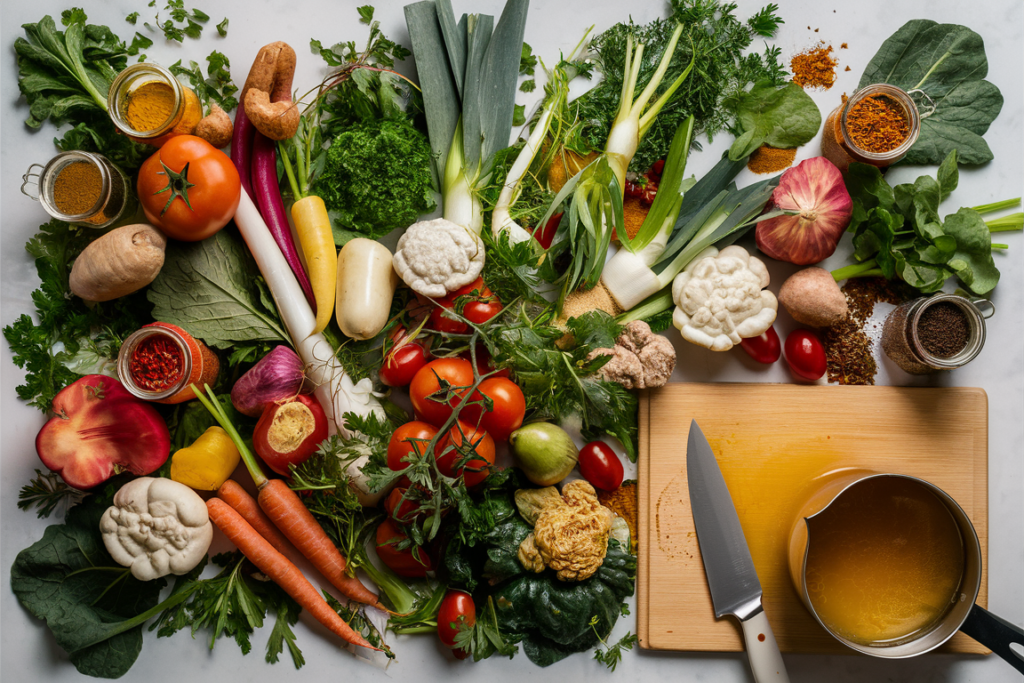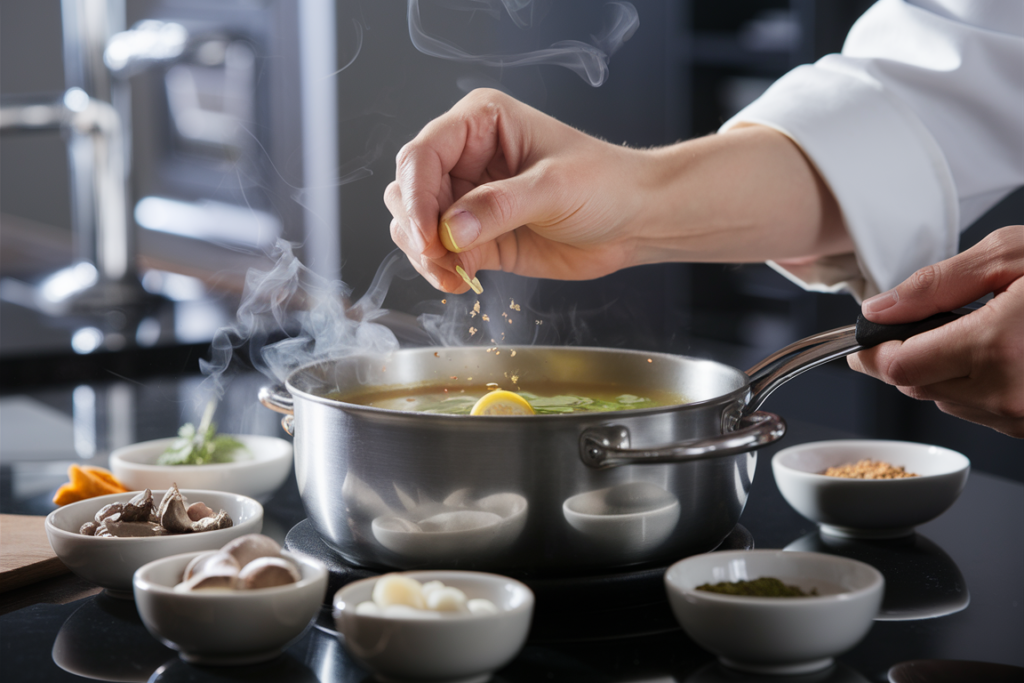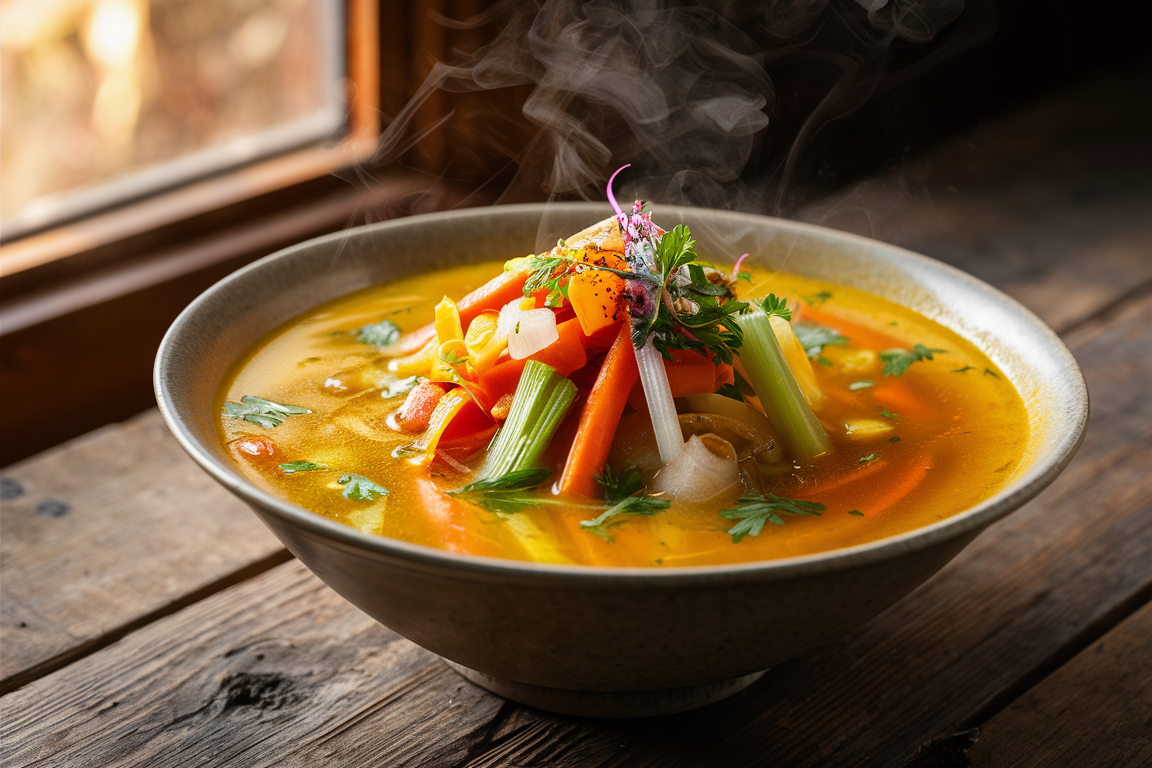Introduction
Few dishes evoke comfort and creativity quite like soup. From a simple broth to a complex bisque, the world of soup is both diverse and deeply rooted in culinary traditions. A well-crafted soup isn’t just about tossing ingredients into a pot; rather, it’s an art form that often hinges on the secret ingredient in soup, which ultimately transforms a good dish into something truly exceptional.
Part 1: The Role of Ingredients in Creating a Flavorful Soup

Soup’s magic lies in its ingredients. Every addition, from the humble onion to the exotic saffron, plays a role in determining its final flavor. Some components act as the foundation, while others—like the secret ingredient in soup—bring depth and nuance.
How a Single Ingredient Can Transform a Soup
One carefully chosen ingredient can change everything. For example, a splash of coconut milk in spicy tomato soup or a hint of parmesan rind in minestrone may serve as the secret ingredient in soup that elevates the dish to new heights.
Historical Secrets: Ingredients That Defined Soups Through the Ages
Throughout history, certain ingredients have elevated soups from basic sustenance to culinary masterpieces:
- Medieval Europe: Herbs like parsley and thyme were staples in hearty stews.
- Asia: Fish sauce has long been a secret weapon in creating deeply savory broths.
- America’s South: Gumbo owes much of its complexity to filé powder, a ground sassafras leaf.
Each region’s soup secrets reflect its unique culinary history, showcasing how culture shapes flavor.
Balancing Flavors: The Art of Sweet, Sour, Salty, and Umami
The balance of flavors is an art form in soup-making. To craft a soup that’s both memorable and satisfying:
- Combine sweet ingredients like carrots or tomatoes to mellow acidity.
- Add a touch of sourness, like vinegar or lemon, for brightness.
- Introduce salt carefully, as it amplifies other flavors.
- Seek umami, the savory essence, through ingredients like mushrooms, soy sauce, or aged cheese.
Mastering this balance transforms your soup into a harmonious bowl of goodness.
Why Simplicity is Key to Great Soups
Sometimes, less is more. Minimalist soups, such as a classic leek and potato, shine because of their simplicity. Using a few high-quality ingredients allows each to stand out, proving that complexity doesn’t always equal better.
Common “Secret” Ingredients Across Different Cultures
Different cultures have their unique soup “secrets,” which often include unexpected ingredients that bring unparalleled depth and flavor.
French Mirepoix: A Base That Elevates
The mirepoix—a mix of onions, carrots, and celery—is the cornerstone of French soups and stews. This trio builds a flavor base that enhances any soup, making it richer and more aromatic. Learning to sauté mirepoix properly is a game-changer for home cooks.
Asian Broths and Their Special Additions
Asian soups, from Japanese ramen to Thai tom yum, often rely on unique ingredients like:
- Dashi: A Japanese broth made from kombu (seaweed) and bonito flakes, packed with umami.
- Galangal and lemongrass: Staples in Thai soups, delivering citrusy warmth.
These ingredients, though distinct, share the common purpose of creating bold and layered flavors.
The Role of Herbs and Spices as Hidden Gems in Soups
Herbs and spices are often the unsung heroes of soups:
- A pinch of cumin can transform a lentil soup.
- Fresh cilantro adds brightness to spicy broths.
- A dash of nutmeg in cream-based soups creates warmth and depth.
When used thoughtfully, these additions can elevate any recipe to new heights.
Part 2: The Science Behind Soup’s Secret Ingredient

A well-balanced soup often revolves around a singular, surprising element. This secret ingredient in soup might be an umami-rich addition, a splash of acidity, or a touch of sweetness that creates a lasting impression.
Understanding Umami: The Fifth Flavor
Ingredients like mushrooms, soy sauce, and tomatoes are known for their umami properties, often serving as the secret ingredient in soup to bring out savory depth and complexity.
Chemical Interactions in Ingredients That Unlock Depth
Soup flavors evolve through chemical reactions, including the Maillard reaction and caramelization:
- The Maillard reaction occurs when proteins and sugars in ingredients brown, creating rich, roasted flavors.
- Caramelization happens when sugars break down, adding sweetness and complexity.
Roasting ingredients like bones, vegetables, or spices before adding them to the pot amplifies these reactions, resulting in a soup with robust flavors.
Enhancing Texture: Secret Ingredients for a Velvety Finish
Texture is as important as flavor in soups. Certain ingredients can deliver a creamy, smooth consistency:
- Starches like potatoes or rice, blended into the soup, create a natural thickener.
- Cream and coconut milk add richness.
- Nut butters such as almond or cashew can give soups a luxurious mouthfeel.
Experimenting with these ingredients ensures your soup is as enjoyable to feel as it is to taste.
Preserving Nutritional Value While Adding Flavor
Soup is celebrated not only for its taste but also for its health benefits. To maximize nutrition:
- Avoid overcooking vegetables, which can leach nutrients.
- Use bone broths rich in collagen for both flavor and health benefits.
- Incorporate nutrient-dense additions like kale, spinach, or lentils late in the cooking process.
Balancing flavor and nutrition is a hallmark of a well-crafted soup.
The Role of Temperature and Timing in Extracting Flavors
Cooking soup requires precision in temperature and timing. Too high a heat can boil away subtle flavors, while too low a simmer might leave ingredients underdeveloped.
How Low and Slow Cooking Brings Out Hidden Tastes
Low, slow cooking allows flavors to meld harmoniously. Ingredients like meat and bones release their essence gradually, creating a layered depth of flavor. For soups like pho or French onion, patience is a key ingredient.
Blanching, Searing, and Roasting: Prepping the Secret Ingredient
Pre-cooking techniques unlock the full potential of your ingredients:
- Blanching vegetables preserves their vibrant color and texture.
- Searing meat or aromatics intensifies their flavor.
- Roasting bones or tomatoes adds a smoky depth that can’t be replicated with raw ingredients.
Each technique contributes to building a foundation that enhances the final soup.
Uncommon Additions: Surprising Ingredients That Work Wonders
Sometimes the most unexpected ingredients are the ones that leave a lasting impression.
Sweet Elements: Honey, Fruit Zest, and Syrups
Adding a touch of sweetness can create a more balanced soup. Consider:
- A drizzle of honey to offset the acidity in tomato soup.
- Orange or lemon zest to brighten creamy soups.
- A spoonful of maple syrup in butternut squash soup for an earthy sweetness.
These elements can transform a simple recipe into a complex, multilayered dish.
Alcohol and Acids: A Splash of Magic
Wine, sherry, or even beer can elevate your soup by introducing both acidity and complexity. Acids like vinegar or citrus juice, when added toward the end of cooking, brighten flavors and enhance balance.
Part 3: Bringing it All Together
Creating a standout soup means balancing tradition with experimentation. Adding your own secret ingredient in soup—whether it’s a fresh herb, a squeeze of citrus, or even a pinch of an unexpected spice—ensures your recipe is unique.

Finding Your Secret Ingredient
Every cook has their own version of the secret ingredient in soup. For some, it might be a pinch of nutmeg in creamy soups; for others, it’s a splash of sherry in a seafood bisque.
Experimenting with Flavors to Find Your Unique Soup Secret
Every cook has a secret ingredient that defines their style. Discovering yours means:
- Exploring unique combinations of aromatics, acids, and fats.
- Trying unconventional ingredients, such as fermented products or exotic spices.
- Tweaking recipes to reflect personal tastes or cultural influences.
Adapting Recipes Based on Seasonal Ingredients
The best soups often depend on fresh, seasonal produce. In winter, root vegetables like parsnips and squash shine, while summer soups benefit from the brightness of tomatoes and herbs. Adjusting your ingredients ensures both flavor and sustainability.
Testing and Tasting: Developing the Perfect Flavor Profile
Don’t be afraid to taste frequently and adjust:
- Add salt or acid gradually to avoid overpowering the dish.
- Use a small test batch if trying a bold or unfamiliar ingredient.
- Incorporate additional spices at the end to fine-tune flavors.
This process ensures that every bowl is balanced and delicious.
The Unexpected Power of Common Pantry Items
Sometimes the secret to great soup lies in everyday pantry staples.
Using Leftovers Creatively as a Secret Weapon
Leftovers can introduce complex flavors to soups:
- Stale bread transforms into a thickener for Italian pappa al pomodoro.
- Leftover roast meats create a rich, flavorful base for broths.
- Cooked grains, like rice or quinoa, add texture and substance.
By repurposing leftovers, you reduce waste and create unique flavor profiles.
Stock and Broth: Building a Strong Foundation for Flavor
A great soup starts with a great base. Homemade stocks and broths are unbeatable:
- Simmer chicken bones with onions, carrots, and celery for a classic broth.
- Use roasted vegetables and herbs to create a robust vegetarian stock.
- Enhance store-bought broths with aromatics, garlic, and a splash of wine for added depth.
This foundation sets the tone for the rest of your soup.
Popular Recipes That Highlight a Unique Ingredient
Certain recipes showcase the power of a single, standout ingredient.
Carrot Ginger Soup with a Hint of Citrus
This vibrant soup combines the sweetness of carrots with the warmth of ginger; furthermore, a splash of orange juice or zest adds brightness, effectively turning a simple recipe into a gourmet experience.
Clam Chowder with Smoky Bacon
The addition of crispy bacon to classic clam chowder not only brings a smoky, savory element but also enhances the creaminess of the soup; moreover, it serves as a perfect example of how one ingredient can truly elevate a dish.
Tips for Home Cooks to Identify Their Own Secret Ingredient
Finding your secret ingredient not only involves creativity but also requires an understanding of flavor pairing; moreover, experimenting with different combinations can help you uncover unique tastes.
Exploring Aromatics, Fats, and Acids
Aromatics like garlic, ginger, or onions are the foundation of most soups. Adding fats, such as butter or olive oil, amplifies flavors, while acids like vinegar or lemon juice brighten them.
How to Pair Ingredients for Maximum Flavor
Certain combinations are tried-and-true:
- Tomato and basil: A classic pairing with universal appeal.
- Cumin and coriander: Common in hearty lentil soups.
- Coconut and lime: A staple in Southeast Asian broths.
Experimenting with these pairings helps you uncover new dimensions of flavor.
More FAQs:
- What is the easiest soup to make for beginners?
- For beginners, a simple chicken noodle soup is ideal because it requires minimal ingredients and, moreover, relies on basic techniques that are easy to follow.
- What is the secret to a clear broth?
- To ensure clarity, you should simmer the ingredients gently; furthermore, make sure to skim impurities regularly throughout the cooking process.
- How can I thicken soup without flour or cream?
- For natural thickeners, you can use blended vegetables, pureed beans, or even soaked bread; additionally, these options enhance the texture without overpowering the flavor.
- What’s the best way to store leftover soup?
- To preserve freshness, cool it quickly; furthermore, store it in an airtight container either in the fridge for up to five days or in the freezer for as long as three months.
- Can I make soup without a stock or broth?
- Yes! Water can be a base when enhanced with aromatics, herbs, and seasoning.
- Why does soup taste better the next day?
- Flavors have time to meld and intensify when the soup rests.
- What’s the difference between bisque and chowder?
- Bisque is smooth and creamy, often made with shellfish, while chowder is chunky and hearty.
- How do I fix a soup that’s too salty?
- Add a raw potato to absorb excess salt or balance the flavor with a splash of acid or sweetness.
- What’s the role of wine in soup?
- Wine adds acidity and depth, enhancing the overall complexity of flavors.
- Can I substitute fresh herbs for dried ones?
- Yes, but use three times as much fresh herb as dried, since dried herbs are more concentrated.

